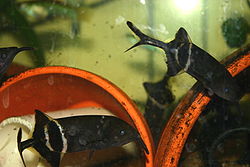- Mormyridae
-
Freshwater elephantfish 
Elephant fish Scientific classification Kingdom: Animalia Phylum: Chordata Class: Actinopterygii Order: Osteoglossiformes Family: Mormyridae Subfamilies Mormyrinae
PetrocephalinaeThe family Mormyridae, sometimes called "elephantfish" (more properly freshwater elephantfish), are freshwater fish in the order Osteoglossiformes native to Africa. It is by far the largest family in the order with around 200 species. Members of the family are popular, if challenging, aquarium species. These fish are also known for having large brain size and unusually high intelligence.
They are not to be confused with the Australian ghost shark (Callorhinchus milii) which is sometimes referred to as the "elephantfish", but is better known as the elephant shark in the scientific community.
Contents
Description and biology
The elephantfishes are a diverse family, with a wide range of different sizes and shapes. The smallest are just 5 centimetres (2.0 in) in adult length, while the largest reach up to 1.5 metres (4.9 ft). They do, however, have a number of unique features in common. Firstly, the cerebellum (part of the brain) is greatly enlarged, giving them a brain to body size ratio similar to that of humans. This is likely to be related to the interpretation of bio-electrical signals. Secondly, the semicircular canals in the inner ear have an unusual structure and are associated with a gas-filled bladder entirely separate from the main swim bladder.[1]
Some species possess modifications of the mouthparts to facilitate feeding upon small invertebrates buried in muddy substrates. The shape and structure of these leads to the popular name of "elephant nosed fish" for those species with particularly prominent mouth extensions. The extensions to the mouthparts usually consist of a fleshy elongation attached to the lower jaw. They are flexible, and equipped with touch, and possibly taste, sensors.
Among those members of the family lacking extended mouthparts, the body shape and general morphology of the fishes has led to some being known among aquarists by the name of "baby whale", despite the fact that true whales are mammals. Other "mormyrid mammalian misnomers" include the term "dolphin fishes", in reference to certain members of the Genus Mormyrops.
Electric fields
Elephantfishes are notable for their ability to generate weak electric fields that allow the fishes to sense their environment in turbid waters where vision is impaired by suspended matter.[1] The generation of these electric fields and their use in providing the fishes with additional sensory input from the environment is the subject of considerable scientific research, as is research into communication between and within species.
Electric discharges are most often pulsatile, with Gymnarchus niloticus being an exception to this rule, discharging its electric organ near approximately 500 Hz, giving it a near-sinusoidal like discharge. The electric organ is developmentally related to muscle, as in Gymnotiform electric fish, as well as in electric rays and skates. There is a surprising degree of convergent evolution between the South American Gymnotiforms and the African Mormyridae, particularly in the sensory apparatus for detecting and processing electrical signals involved in electrolocation and electrocommunication.
Classification
There are about 200 species of elephantfish, grouped into two subfamilies, Mormyrinae and Petrocephalinae. The latter has only a single genus:
Family Mormyridae
- Subfamily Mormyrinae
- Boulengeromyrus Taverne & Géry, 1968
- Brienomyrus Taverne, 1971
- Campylomormyrus Bleeker, 1874
- Cyphomyrus Pappenheim, 1906
- Genyomyrus Boulenger, 1898
- Gnathonemus Gill, 1863
- Heteromormyrus Steindachner, 1866
- Hippopotamyrus Pappenheim, 1906
- Hyperopisus Gill, 1862
- Isichthys Gill, 1863
- Ivindomyrus Taverne & Géry, 1975
- Marcusenius Gill, 1862
- Mormyrops J. P. Müller, 1843
- Mormyrus Linnaeus, 1758
- Myomyrus Boulenger, 1898
- Oxymormyrus Bleeker, 1874
- Paramormyrops Taverne, Thys van den audenaerde& Heymer, 1977
- Pollimyrus Taverne, 1971
- Stomatorhinus Boulenger, 1898
- Subfamily Petrocephalinae
- Petrocephalus Marcusen, 1854
References
- Froese, Rainer, and Daniel Pauly, eds. (2006). "Mormyridae" in FishBase. January 2006 version.
- One of several papers on electrogenesis and electric field sensing in Gnathonemus petersi
- Detailed research paper on the sensory and central nervous systems in Gnathonemus petersi
- Another page covering the electrosensory capabilities of Mormyrid fishes
- Mormyrids in the aquarium
- summary of a research on the blue jawed elephant nose from JEB
Categories:- Mormyridae
- Fish of Africa
- Subfamily Mormyrinae
Wikimedia Foundation. 2010.
